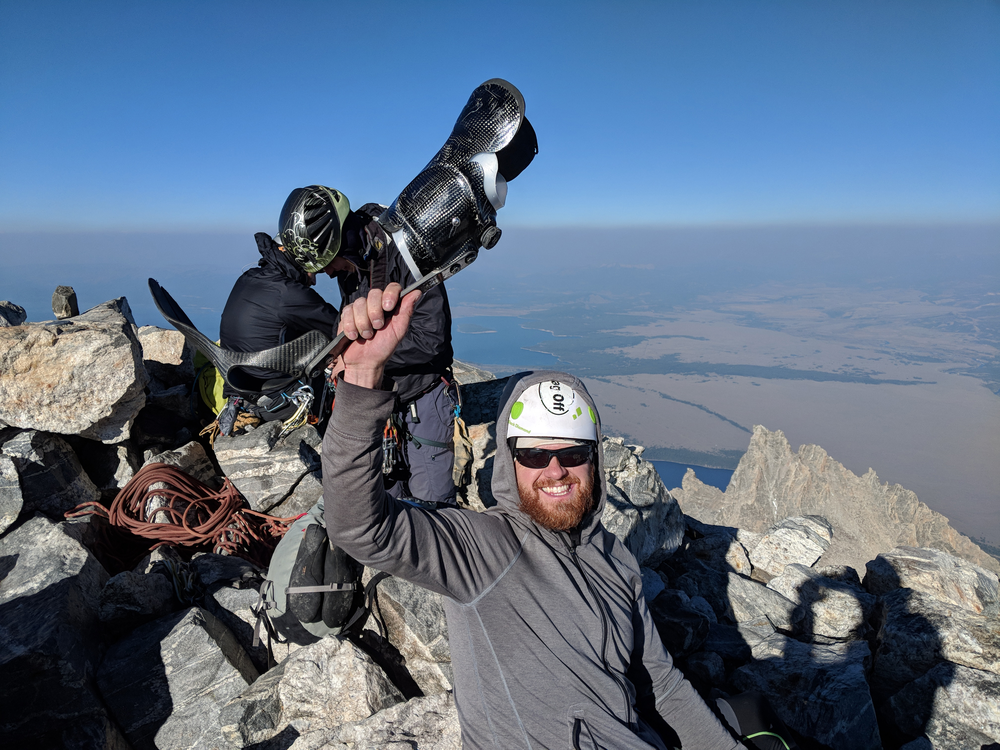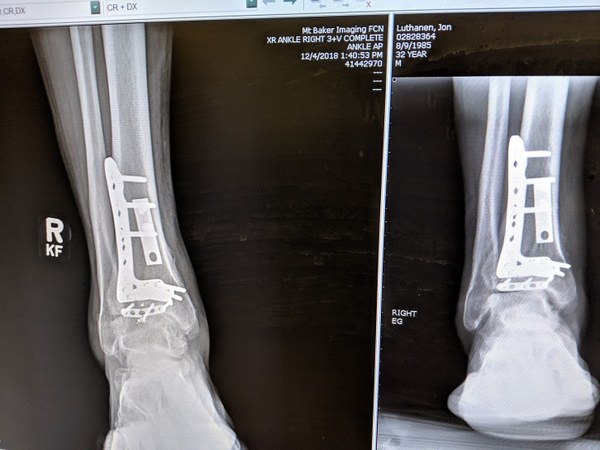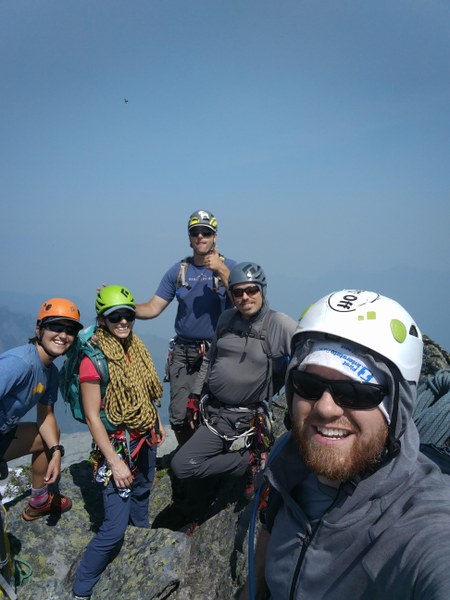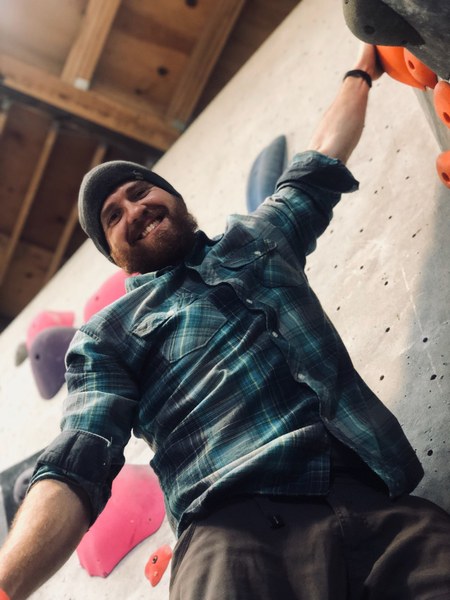
Jon Luthanen is a climber, mountaineer, and active member in our Bellingham Branch. He was on a climbing trip in southern Utah in May 2017 when he experienced a traumatic ankle injury while bouldering outside. He needed major surgery, and now requires a carbon fiber leg brace to pursue his outdoor passions. In this interview, Jon shares the story of his injury, his recovery, and why he chose our Basic Alpine Climbing Course to support his reentry into the outdoors.
How did you fall in love with the outdoors?
I’m a bit of a mutt. I was born in Kentucky, raised in Connecticut, and then moved to Ohio. After college, I moved to Bozeman, Montana, where I worked with AmeriCorps for a couple years. I had never lived any place mountainous before, and I fell in love immediately. I resolved at that point to never live in the flatlands again. I got into climbing in Bozeman when my buddy John invited me out. Unbeknownst to me, I was seeking community after having exited collegiate athletics, and he kind of took me under his wing. John was four or five years older than me and had a little bit more life experience and a lot more technical climbing ability. We summited several local peaks and I was hooked. I moved to Bellingham in 2013. The setting is similar to Bozeman in that it’s a really beautiful town with lots of young, outdoorsy energy.
Can you tell me about your injury?
I was visiting a buddy in southern Utah in the Saint George area, with the intention of summiting a local 10,000-ft peak. He was a bit tied up with work, so one of his housemates, who I didn’t know very well, suggested that we go bouldering in Moe’s Valley. Prior to this I had a good amount of indoor bouldering experience. We'll go ahead and say overconfidence took the reins in my decision making that day, because I felt pretty sure of myself on introductorylevel routes. But it's very different when the entire floor is a gym mat versus rock with only a crash pad for protection. We went up one or two routes that were pretty easy - V3 or V4 tops. The route I was on wasn’t very technical at all – again, introductory level. And it was highball. (Editor’s note: “highball” boulders are boulder problems that are particularly high off the ground, typically over 10-15 feet). I was at the last move, 10 to 12 feet above the ground, and I went to grab something with my left hand that looked really sturdy… and it was not.
My left hand popped off and my left foot shortly after. With my feet directly below me, I looked down and my crash pads were about a foot to the left of me. I hit hard-pack dirt and rock and knew instantaneously that I had broken something – I felt it, I heard it. I’ve broken bones before, so I was mainly just annoyed at the situation. We were about three quarters of a mile away from my buddy’s truck, and we both had some Wilderness First Aid training. We packed up all the gear and hopped out of there and got into an urgent care facility. The injury happened at 3:30pm and by 5pm I had already gotten X-rays, a walking boot, crutches, and was out the door. The doctor said “Eh, maybe surgery, maybe not, go back to your orthopedic doctor in Bellingham, see what they have to say.” And he sent me on my way. What the doctor in Bellingham told me was a different story.
How was the recovery process?
After additional X-rays and MRIs to both my foot and my wrist, which I had also landed on, I heard what every outdoorsy person never wants to hear. The urgent care doctor in Utah had said “Maybe surgery.” My orthopedic surgeon in Bellingham, Dr. Warren Taranow, said “No no – anyone who told you anything but surgery either has no idea what they’re talking about or didn’t want to ruin your summer. And I’m here to ruin your summer.” He told me I had sustained a severe pilon fracture to my right ankle, and the injury would permanently disable me.
He immediately followed up with questions about what I like to do. He said he could get me back to climbing and skiing, though we both agreed bouldering was something I could give up. I asked if I could run and he said, “Well, now… maybe you’ll pick up a sport like swimming or biking.” And I’m sitting there, stiffening up in my chair, at the time age 31. “The repetitive impact on that injury site is not something that people who undergo the surgery usually entertain as it’s too painful.” My immediate thought was “yeah, let me tell you what I’m going to do.”
I spent two months non-weight bearing on a one-legged scooter, one month in a walking boot with crutches, and an additional month with just the boot. It was three months of occupational therapy followed by three months of physical therapy for my wrist and ankle, respectively. Following physical therapy at the end of 2017, Cornerstone Orthotics & Prosthetics built me an AFO carbon fiber leg brace.
 Hardware installed in Jon’s ankle. Photo courtesy of Jon Luthanen.
Hardware installed in Jon’s ankle. Photo courtesy of Jon Luthanen.
Why did you choose to take The Mountaineers Basic Climbing Course as you were starting to become active again?
It was a multi-tiered decision. For one, I’ve been climbing for a long time and I wanted to take an introductory course to refresh my skills and pick up some new ones. The course is also spaced out over several months, which allowed me to continue to rehab over a decent time frame and push the envelope a little bit each time. It was also a safe program, where I could push my limits with the knowledge that I’d be in lower-risk situations. I wanted to be around people that could look after me in the event that things went wrong.
What was it like re-entering the outdoor world?
It was less than smooth. For our first climbing practice night for the Basic Climbing Course we met at the local YMCA’s 70-ft indoor rock wall. We typically started our meetings at 7pm. I wanted to show up early because I knew I was putting rock climbing shoes back on for the first time since my injury. I was not excited - it was nerve wracking, and I didn’t know how my foot was going to respond. So in my mind, I was going to show up half an hour early. Turns out I was half an hour late; our meeting time had been moved up due to time constraints at the Y. There was a lot of noise and commotion – many bodies in a confined climbing space. I felt flustered and had to throw my gear on really quickly, fumbling through my knots and making several mistakes. To say that my reentry into the world of climbing was a rough one would be just touching the surface. I did not have a good time that night.
When did your anxiety around climbing start to subside?
I've never really been a “climber” climber. I hadn’t done a lot of technical rock climbing prior to the course last year. I’d dabbled, and I've climbed a number of peaks that I feel I probably could've had more protection on. But one of the reasons I signed up for the Basic Climbing Course was to get a more well-rounded climbing experience. The rope skills part of the course was foreign to me, but by the time we progressed into our snow units I was in my comfort zone. I'd been climbing mountains for almost a decade, so walking on snow made me feel much more in my element. I also felt like I had physically gotten stronger and more confident through the course requirements of hiking and backpacking. The brace started to feel like an extension of my body, and I didn't feel awkward using it anymore.
 Jon Luthanen with climbing partners Tim Duryee, Andrew Hollen, Maura Rendes, and Sydney Lopez DeVic on Mt. Watson. Photo courtesy of Jon Luthanen.
Jon Luthanen with climbing partners Tim Duryee, Andrew Hollen, Maura Rendes, and Sydney Lopez DeVic on Mt. Watson. Photo courtesy of Jon Luthanen.
How has the brace affected you on trips?
My leg brace was built to allow me to run and climb again, and at first it seemed clunky and made me kind of unsure of my footing. But I noticed a couple awesome benefits as the course progressed. It has a slightly spring-loaded step – because my calf is not allowed to flex while I’m in it, muscles that might typically get torched early on a hike don’t fatigue. My kick steps in snow are also rock solid because my foot is locked in at 90 degrees. Another funny, positive side effect is seen going down less technical snow terrain. In snow people can boot ski, or use your feet to kind of slide. I essentially have a built-in ski blade on my right foot. My ankle’s not going to flex and move anywhere, so I can get a running start and one-leg it down snow. It’s a great, efficient way to get down a mountain.
That said, one thing that is difficult is transitioning from snow to rock. It’s definitely something I've never had to think about before, but now that my ankle can’t flex it’s difficult to get a grip on loose rock or scree with that foot. Smearing is out for me on slabs, and it would be very difficult to crack climb even without the brace on.
What’s next for you?
I'm actually back in a walking boot. In November I started testing my ability to run indoors, and I came away from a workout limping the next day – nauseous with every step. I thought I'd just overused my ankle, but went in for an X-ray. A bone spur had developed near the bottom of my tibia, and it collapsed and fractured one of the plates installed in my leg. The same surgical team went in and removed almost all of the hardware in February. I have another 6 weeks in a walking boot before I start physical therapy again.
That said, I just entered grad school. I had planted that seed two years ago, when I was completely disabled. So there's a lot of energy focused on that right now. As for climbing, I should be fully back in action soon.
I'm also going to volunteer with the Basic Course in Bellingham. Post-surgery I'll be a bit limited, but it's nice to refresh my skills as a volunteer leader. Every year I try to build a list of climbing objectives. It’s going to be a forever list – it’s a revolving door as I check things off. I try to hit one major objective at the end of every year, and essentially build myself up to that as the summer progresses. Mount Hood has been on my radar for quite a while. There’s also an organization called Summit for Someone that fundraises through guided climbs. They donate funds toward a program that gets intercity youth into the wild through week-long camping trips. There are times in climbing, especially mountaineering, where summiting can be ego-centric, and I think this could be a great way to try to give back while doing something that I really enjoy.
What would you tell folks newly dealing with a traumatic injury?
It’s easy to be defeated by situations like this. To give in, to get down on yourself and the situation, maybe to only feel the pain or see the negative. I would challenge anyone facing similar circumstances to buck that trend and have more of a ‘come what may’ attitude. There’s a lot of life left to live, and if you're passionate enough to be a climber, in particular someone who enjoys mountaineering, then suffering is a part of that experience. From that perspective, it seems embracing pain, becoming familiar with it, and channeling that energy into positive pursuits helps. Whether that's physical therapy, going to the gym, or socializing with your friends, the key is to not isolate yourself - even if that is the easier choice.
I heard a quote recently, “Never let a crisis go to waste”. I kind of love that, and have been using it to guide my decision making since the fall. With my experience, there were lessons learned, wounds licked, and I was more clearly able to see my path after having such a traumatic injury. Again, probably no more outdoor bouldering, but I still chase the things that I want - just with minor physical alterations. It'd be cool if in any way, shape, or form, telling this story helps someone facing similar circumstances. I remember feeling helpless when I was told what my trajectory would be for this from a medical perspective. It’s helpful to know that you have a lot of options, and that you may be the one limiting your particular situation. It’s all a mental game. But as long as you can overcome that, the sky’s the limit.
 Photo courtesy of Jon Luthanen.
Photo courtesy of Jon Luthanen.
Jon offered this piece in commemoration of his father, Bruce Alan Luthanen (09/13/56 - 03/25/19). “I’ve been provided the opportunity to pursue the things I love because of Dad,” Jon says. He will be dedicating all of his 2019 climbs to his father.
This article originally appeared in our Summer 2019 issue of Mountaineer Magazine. To view the original article in magazine form and read more stories from our publication, click here.
 Hailey Oppelt
Hailey Oppelt